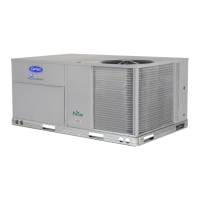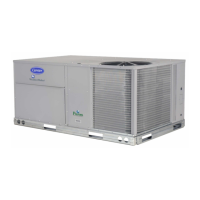41
.
If IQ.A.F is configured to request the supply fan, then configu-
rations D.F.ON and D.F.OF need to be set. These configura-
tion settings are located under Configuration
IAQ
AQ.SP
and configure the fan override operation based on the differen-
tial air quality (DAQ). If DAQ rises above D.F.ON, the control
will request the fan on until DAQ falls below D.F.OF.
NOTE: If D.F.ON is configured below DAQ.H, the unit is in oc-
cupied mode, and the fan was off, then DAQ rose above D.F.ON
and the fan came on, the economizer will go to the economizer
minimum position (EC.MN).
The 4 to 20 mA signal from the sensor wired to TB201-8 and
TB201-7 is scaled to an equivalent indoor CO
2
(IAQ) by the pa-
rameters IQ.R.L and IQ.R.H located under the Configuration
IAQ
AQ.S.R menu. The parameters are defined such that 4 mA
= IQ.R.L and 20 mA = IQ.R.H. When the differential air quality
DAQ (IAQ – OAQ.U) exceeds the DAQ.H set point (Configura-
tion
IAQ
AQ.SP menu) and the supply fan is on, the econo-
mizer minimum vent position (Configuration
IAQ
DCV.C
EC.MN) is overridden and the damper is moved to the IQ.P.O
configuration. When the DAQ falls below the DAQ.L set point
(Configuration
IAQ
AQ.SP menu), the economizer damper is
moved back to the minimum vent position (EC.MN).
NOTE: Configuration OAQ.U is used in the calculation of the trip
point for override and can be found under Configuration
IAQ
AQ.SP.
IQ.A.C = 3 (4 to 20 mA Damper Control)
This configuration will provide full 4 to 20 mA remotely con-
trolled analog input for economizer minimum damper position.
The 4 to 20 mA signal is connected to terminals TB201-8 and
TB201-7. The input is processed as 4 mA = 0% and 20 mA =
100%, thereby giving complete range control of the effective
minimum position.
The economizer sequences can be disabled by unplugging the
enthalpy switch input and not enabling any other economizer
changeover sequence at Configuration
ECON
E.SEL.
Complete control of the economizer damper position is then pos-
sible by using a 4 to 20 mA economizer minimum position con-
trol or a 0 to 10,000 ohms 0 to 100% economizer minimum posi-
tion control via configuration decisions at Configuration
IAQ
IQ.A.C.
To disable the standard enthalpy control input function, unplug
the enthalpy switch and provide a jumper from TB201-6 to
TB201-5 (see wiring diagrams in Major System Components
section on page 129).
IQ.A.C = 4 (10 Kilo-ohm Potentiometer Damper Control)
This configuration will provide input for a 10,000 ohm linear
potentiometer that acts as a remotely controlled analog input
for economizer minimum damper position. The input is pro-
cessed as 0 ohms = 0% and 10,000 ohms = 100%, thereby giv-
ing complete range control of the effective minimum position.
NOTE: For complete economizer control, the user can make
the economizer inactive by unplugging the enthalpy switch
connection.
CONTROLS OPERATION
Modes
The ComfortLink controls operate under a hierarchy of com-
mand structure as defined by three essential elements: the Sys-
tem mode, the HVAC mode and the Control mode. The System
mode is the top level mode that defines three essential states
for the control system: OFF, RUN and TEST.
The HVAC mode is the functional level underneath the System
mode which further defines the operation of the control.
The Control mode is essentially the control type of the unit
(Configuration
UNIT
C.TYP). This defines where the con-
trol looks to establish a cooling or heating mode. Furthermore,
there are a number of modes which operate concurrently when
the unit is running. The operating modes of the control are locat-
ed at the local displays under Operating Modes. See Table 30.
Table 30 — Operating Modes Display Table
Currently Occupied (OCC)
This variable displays the current occupancy state of the unit.
Timed Override in Effect (T.OVR)
This variable displays if the state of occupancy is currently oc-
cupied due to an override.
DCV Resetting Minimum Position (DCV)
This variable displays if the economizer position has been low-
ered from its maximum vent position due to demand-controlled
ventilation.
Supply Air Reset (SA.R)
This variable displays if the supply air set point that the rooftop
is attempting to maintain is currently being reset upwards. This
applies to cooling only.
Demand Limit in Effect (DMD.L)
This variable displays if the mechanical cooling capacity is
currently being limited or reduced by a third party.
Temperature Compensated Start (T.C.ST)
This variable displays if Heating or Cooling has been initiated
before occupancy to pre-condition the space.
IAQ Pre-Occupancy Purge Active (IAQ.P)
This variable displays if the economizer is open and the fan is
on to pre-ventilate the building before occupancy.
Linkage Active CCN (LINK)
This variable displays if a linkage master in a zoning system
has established “linkage” with this air source (rooftop).
Mechanical Cooling Locked Out (LOCK)
This variable displays if mechanical cooling is currently being
locked out due to low outside air temperature.
HVAC Mode Numerical Form (H.NUM)
This is a numerical representation of the HVAC modes which
may be read via a point read.
IQ.A.F = 0 IAQ analog sensor input cannot start the sup-
ply fan
IQ.A.F = 1 IAQ analog sensor input can start the supply
fan in occupied mode only
IQ.A.F = 2 IAQ analog sensor input can start the supply
fan in both occupied and unoccupied modes
ITEM EXPANSION RANGE CCN POINT
SYS.M ascii string n/a
HVAC ascii string n/a
CTRL ascii string n/a
MODE MODES CONTROLLING UNIT
OCC Currently Occupied ON/OFF MODEOCCP
T.OVR Timed Override in Effect ON/OFF MODETOVR
DCV DCV Resetting Min Pos ON/OFF MODEADCV
SA.R Supply Air Reset ON/OFF MODESARS
DMD.L Demand Limit in Effect ON/OFF MODEDMLT
T.C.ST Temp.Compensated Start ON/OFF MODETCST
IAQ.P IAQ Pre-Occ Purge Active ON/OFF MODEIQPG
LINK Linkage Active — CCN ON/OFF MODELINK
LOCK Mech.Cooling Locked Out ON/OFF MODELOCK
H.NUM HVAC Mode Numerical Form number MODEHVAC

